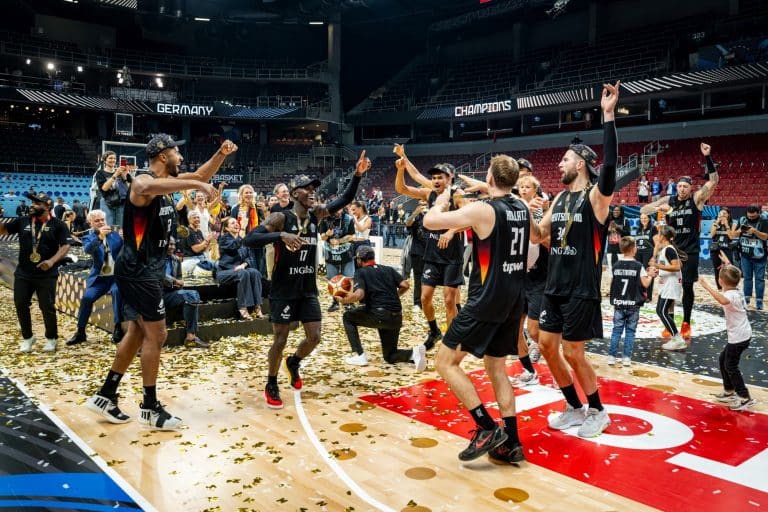Part 1: Stars vs. Orchestrators – What really makes good leadership (on and off the field)?
Dennis Schröder led the German national basketball team to the World Cup title in 2023 and to victory in the European Championships in 2025. He was named MVP (Most Valuable Player) both times. Luka Dončić, on the other hand, is considered one of the best individual basketball players of his generation. His performance at the European Championship also earned him a well-deserved place in the All-Star Team, just like Schröder. So what are the basketball leadership lessons?
Image sources: at the end of the article
Dončić’s statistics are outstanding:
Points, assists, rebounds – at the European Championships, he averaged 34.7 points per game and scored a total of 243 points in seven games. And yet, he has yet to win a major title with Slovenia. Slovenia lost to Germany 99-91 in the quarterfinals of the 2025 European Championships.
Schröder averaged “only” 20.3 points per game, scoring a total of 183 points in nine games – significantly less than Dončić, who played seven games. However, Schröder had a decisive impact on the overall success.
The first question about basketball leadership lessons is:
Is individual brilliance sufficient? Or does a diverse team with strong team intelligence lead to lasting success?
Basketball leadership lessons: How could one attempt to categorize both?
Luka Dončić – the brilliant individualist?
Dončić is more than just a natural talent. He takes responsibility, shoots at crucial moments, and shines with spectacular passes. But his game often seems like a one-man show. His teammates stand in his shadow and the burden is hardly shared.
In a business context, he reminds me of a highly competent individualist who shines with brilliance, while the organization is unable to keep up for various reasons. Success depends on his performance – and that is both an opportunity and a risk. Logically, the small country of Slovenia (with a population of just 2.1 million) has not (yet) managed to field a similarly homogeneous range of players as Germany, which is 40 times larger.
Dennis Schröder – the orchestrating leader?
Schröder impresses less with pure statistics or bare figures than with his influence.
He reads the game, motivates his teammates, takes responsibility at the right moment, and thereby makes others stronger. In the last two major tournaments, Schröder had a team around him in which players such as Theis, Bonga, Wagner, Lo, Thiemann, Voigtmann, and Obst could score 20 points per game at any time.
He is the leader who distributes energy and balls, thus making the system work. In professional life, he is the manager who not only performs excellently himself, but also orchestrates the overall performance of the team and puts his colleagues in the spotlight.
Have I forgotten something? Another important point is:
Leadership on the sidelines – the role of trainers and coaches – Basketball Leadership Lessons
Álex Mumbrú, head coach of the German national team, did not have a good start to the World Cup. He had to undergo major surgery immediately after arriving in Tampere, Finland, and only returned to the sidelines after a week. But after that one game, it was clear that he was not yet fit. So he immediately handed the reins back to his assistant coach, Alan Ibrahimagic.
This brings us to the second important leadership question:
What happens in your company when the CEO is unavailable? Is it possible to have a smooth transition like at DBB? Does the management team also act as a team? Does the team continue to support the CEO, like the DBB team supports Alex Mumbru?
Let’s focus again on the “game” or the two protagonists.
Neither of the two top players acts in isolation or in a vacuum. Behind every player and the entire team are trainers and coaches. The German team has five trainers and a total of 13 people in the delegation (including the president, physiotherapist, etc.) for twelve players on the field.
The coaching team defines the playing systems, roles, and playing philosophies. It decides whether stars are integrated or “set free.” The coaches pull the strings in the background: they give confidence, reflect, strengthen roles, correct, and turn talents into real leaders. And they mold the team into a close-knit unit—together with people like Dennis Schröder.
Digression No. 2: In this article, I deliberately do not distinguish between trainer and coach. This is because these two roles are often combined in one person.
Hence my question to readers: How do you assess these roles or their combination in one person? I look forward to stimulating comments and experience reports.
Another look at a sport that is very successful in Germany.
Bernhard Peters, the world champion coach of the national hockey team, described the path to the title as follows: The team came up with a motto. We all followed it. My job was to empower the team as a whole and to coordinate with the two or three leading players so that what had been agreed upon beforehand would be implemented on the field. His own influence during the game was rather limited. It all depended on the leading players.
In basketball, it’s certainly a little different.
Unlike field hockey, which has eleven players, basketball has only five players on the significantly smaller court at any one time. The possibilities for timeouts and coaching phases, as well as the half-size team, offer other opportunities for influence. Anyone who observes timeouts – in both handball and basketball – will notice that the coach gives instructions, but the leading players are also given space to make announcements, e.g., what should happen next or be left alone, or what the next move should be.

Image source: see below DBB
Gordon Herbert recognized Schröder’s potential.
Dennis Schröder benefited from the fact that former national coach Gordon Herbert deliberately cast him in the role of leader, as primus inter pares. And that despite the fact that Schröder used to be a brat and a poker player. In the period since 2013, he has certainly gambled away his chances on occasion (source).
Dončić, on the other hand, perhaps had to carry too much of the burden alone in Slovenia.
Basketball leadership lessons: “Stars win games, coaches and systems win championships.”
Speaking of stars: a brief digression—how much money is involved in a tournament like this?
Basketball has also become a big money sport. But much less so than soccer. How much money are we talking about? In Germany, the DBB association pays out €30,000 per player. By way of comparison, in the men’s soccer World Cup, a European Championship victory would have meant €400,000 per player, while in the women’s tournament it would still have been €120,000 per player. This does not include additional payments from the respective organizing association.
It is comparatively little money. But that’s how it should be.
Basketball leadership lessons: What can C-level executives learn from this?
Individual brilliance is valuable, but it is not enough for lasting success.
- Game intelligence, i.e., the ability to make smart decisions in real time, is more important than pure statistics.
- Talent can only flourish in strong systems and clear cultures.
- Timeouts and substitutions at the right time provide protection, feedback, rest periods, and motivation—in other words, they are worth their weight in gold.
- Sharing responsibility makes organizations resilient.
- Coaching is the key lever for success.
- When an important leader is unavailable, the team must be strong enough to compensate for this loss.
Conclusion for Basketball Leadership Lessons Part 1:
Sustainable success does not come from stars alone, but from teams, systems, and leadership that combine individual brilliance and orchestrated game intelligence.
Part 2 Basketball Leadership Lessons: Coaches and trainers are the invisible force behind leadership.
Coaches are the architects of strategy. They establish systems, empower, give and demand discipline, define roles, and decide how stars are integrated.
Coaches provide feedback, motivate, and spread the word. They instill confidence, strengthen roles, and develop talent.
The example of Schröder shows that coach Gordon Herbert’s conscious decision to give Schröder the leadership role allowed him to grow into it. As a person and as a player. With Dončić, there is a different risk: Slovenia relies too much on its superstar and exceptional talent. His teammates—or even the entire team—may not be performing to their full potential.
Basketball leadership lessons: “Stars win games—coaches and systems win championships.”
What other lessons can the team learn from C-level executives?
- Leadership is not an individual achievement, but rather the product of leadership teams, squads, key players, playing systems, and ongoing communication and regular coaching.
- Without individual coaching geared toward a common goal, even the greatest talent remains underutilized.
- Companies need both internal and external coaches to leverage potential.
- The coaching or leadership team consists of several people (including video and player observers).
- Without regular training, there is no routine, no blind understanding of running paths, and no chance for moments of surprise.
- “Regular training” means both the individual and the team. That means fitness, tactics, coordination, and mental training. All players must be at a high, consistent level. This also means that game and sequence situations, such as in the 4 x 100-meter relay, must be trained over and over again, anticipated, and observations of the environment must be made. In addition, game situations must be adapted at lightning speed depending on the opponent’s behavior.
Conclusion for Part 2 of the Basketball Leadership Lessons
Regular training is just as important in business as it is in sports. It encompasses both individual and team training and includes technical skills, IT know-how, the use of software systems, mastery of processes, and secure procedures and handover processes. This is particularly evident when the unexpected happens. GDPR requests, new competitive behavior, or changed conditions (customs duties, laws, etc.).
Targeted coaching and strategic system design are the hidden forces behind leadership. They transform individual brilliance into sustainable success.
Working “on the system” or “in the system”
Coaches work “on” the system (the team), while the captain acts “within” the system (within the team). Doing both at the same time—as player-coaches attempt to do—does not work at a high level.
Basketball leadership lessons: This raises further questions about leadership and reflection:
- Who am I? If so, how many? Am I a coach, assistant coach, Schröder, Dončić, or a combination of several?
- And once I am clear about my role, are all the other roles in my environment filled appropriately? Are we a team or a collection of individualists? Do we “play” well together, or do employees feel that there is no team on the field here?
Finally, seven leadership lessons for business and C-level executives
- Regular training
- for both individuals and teams is critical to success.
- Individual brilliance ≠ collective success.
- Stars alone rarely carry the day. Success needs enablers.
- Game intelligence beats pure strategy.
- Real-time decisions are critical to success.
- The right environment is decisive.
- Talent only flourishes in strong systems and clear cultures.
- Leadership means sharing responsibility
- In the coaching team, but also in the team: Schröder involves others, Dončić carries the load alone – the former is more sustainable.
- Trainers and coaches are catalysts for success
- Without smart trainers and coaches, even stars remain underperforming.
- Homogeneity is key – both in the management team and elsewhere
- A finely tuned mix of generalists and specialists is needed.
Image sources:
Luka Doncic: “Luka Doncic and Anderson Varejao” by Erik Drost, CC BY 2.0
Dennis Schröder: https://www.basketball-bund.de/eurobasket-unsere-gold-helden/
Celebration photo: https://www.basketball-bund.de/dbb-herren-auf-platz-zwei-der-weltrangliste/












